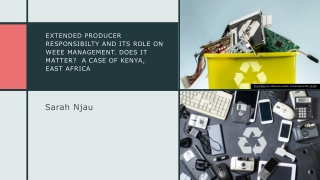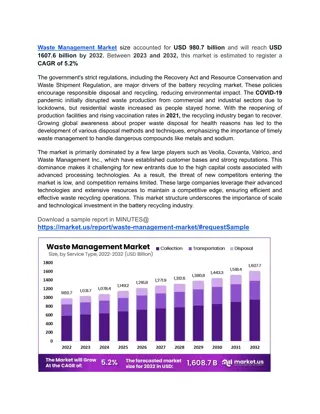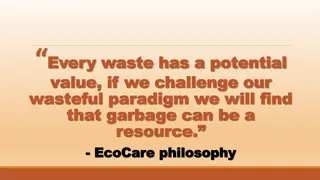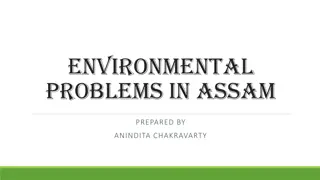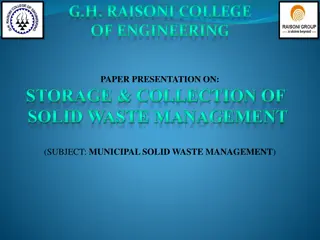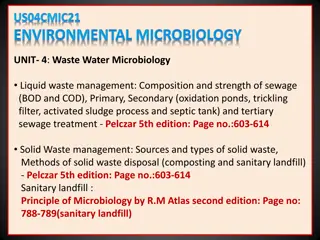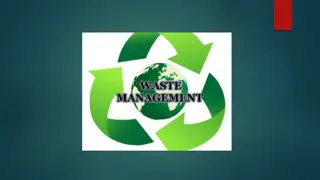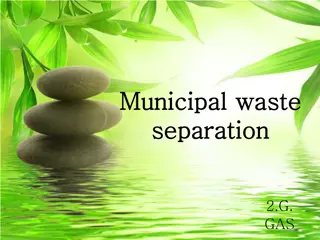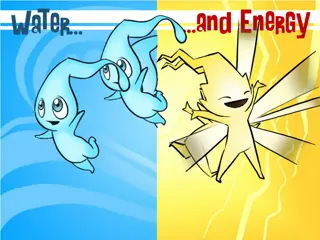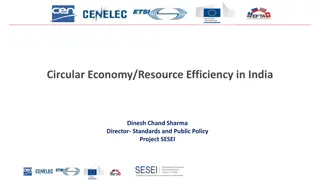E-Waste Management Legislation in Kenya: Challenges and Solutions
Understanding e-waste in Kenya, this presentation by Dr. Ayub Macharia explores the current situation, legislation, challenges, and solutions related to electronic waste management. It highlights the lack of data on e-waste, existing laws, producer responsibilities, and the conceptualization of ongoing challenges in handling electronic waste.
Download Presentation

Please find below an Image/Link to download the presentation.
The content on the website is provided AS IS for your information and personal use only. It may not be sold, licensed, or shared on other websites without obtaining consent from the author. Download presentation by click this link. If you encounter any issues during the download, it is possible that the publisher has removed the file from their server.
E N D
Presentation Transcript
E-WASTE MANAGEMENT LEGISLATION IN KENYA By Dr. Ayub Macharia Director, Environmental Education and Awareness Ministry of Environment and Forestry
Outline of presentation What is e-waste? E-waste situation in Kenya Current legislation Existing challenges in E-waste management How Kenya conceptualize ongoing e-waste challenge Extended Producer Responsibility Regulations 2020 Producer Responsibility on E-waste management
What is E-waste? E waste refers to all electrical or electronic equipment (EEE) that is no longer functional, fit for purpose or has been discarded by the owner. May also refer to end of life Electrical and Electronic Equipment (EEE)
E-waste situation in Kenya Inadequate data on E-waste in Kenya Kenya had a total of 57.3 million mobile phone subscribers by June 2020 Internet users were 41.5 million by June 2020 119.9% mobile penetration in the country Last mile electricity connection programme led to increased use of EEE COVID 19 accelerated need for e-transactions
What laws are currently in use? Constitution of Kenya 2010 EMCA 1999 Waste Management Regulations 2006 Public Procurement and Disposal Act 2015 E-waste guidelines 2011 National E-waste Strategy 2019 Draft E-waste regulations
Existing challenges in E-waste management E-waste dumped everywhere not considering its toxic nature Huge volumes held by consumers Obsolete technology e.g. analogue broadcasting gadgets not yet disposed. Tracing mechanism very poor Informal handlers who operate in secretive way Only 3 licensed e-waste handlers Inadequate e-waste handling infrastructure
How Kenya conceptualize ongoing e-waste challenge Producers preference to introduce EEE gadgets Producers not bound to take responsibility for their obsolete EEE Extended producer Responsibility gap Lack of EPR responsible for Low collection and appropriate disposal of E-waste Low investment in e-waste processing infrastructure E-waste dumping everywhere
Extended Producer Responsibility Regulations 2020 Kenya is finalizing the EPR regulations 2020 E-waste is subject to EPR schemes Producers will be responsible for post consumer disposal of e-waste Producers expected to coalesce together to establish Producer Responsibility Organization. Only one EPR anticipated for EEE but NEMA can allow more EPRs based on complexity of EEE
Producer Responsibility on E-waste management All producers have the following obligations All producers to be registered by NEMA To be members of appropriate Producer Responsibility Organizations (PRO). All producers to pay fees to PRO for execution of EPR obligations PRO to execute EPR on behalf of the members PRO to procure services of E-waste Recyclers, collectors and transporters prior to annual licensing by NEMA. PRO to submit 2 year EPR plan prior to registration by NEMA. PRO to declare volumes of E-waste processed annually PRO to declare funds invested in waste management Both PRO and Producer to be prosecuted in case of breach of EPR obligations




